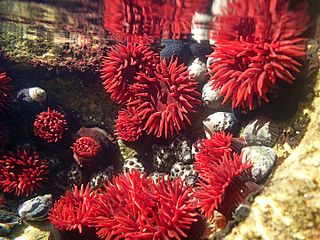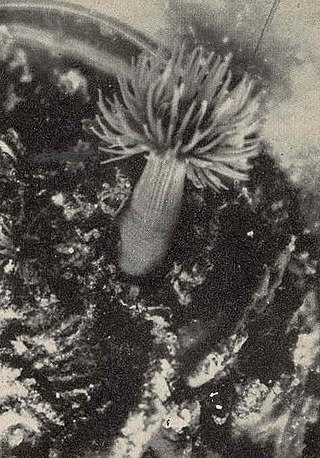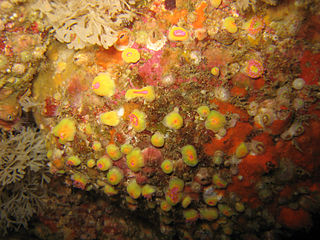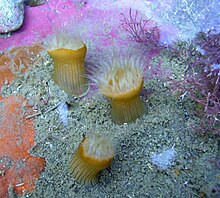
A polyp in zoology is one of two forms found in the phylum Cnidaria, the other being the medusa. Polyps are roughly cylindrical in shape and elongated at the axis of the vase-shaped body. In solitary polyps, the aboral end is attached to the substrate by means of a disc-like holdfast called a pedal disc, while in colonies of polyps it is connected to other polyps, either directly or indirectly. The oral end contains the mouth, and is surrounded by a circlet of tentacles.

Heteractis magnifica, also known by the common names magnificent sea anemone or Ritteri anemone, is a species of sea anemone belonging to the Stichodactylidae family native to the Indo-Pacific area.

The aggregating anemone, or clonal anemone, is the most abundant species of sea anemone found on rocky, tide swept shores along the Pacific coast of North America. This cnidarian hosts endosymbiotic algae called zooxanthellae that contribute substantially to primary productivity in the intertidal zone. The aggregating anemone has become a model organism for the study of temperate cnidarian-algal symbioses.

Bubble-tip anemone is a species of sea anemone in the family Actiniidae. Like several anemone species, E. quadricolor can support several anemonefish species, and displays two growth types based on where they live in the water column, one of which gives it the common name, due to the bulbous tips on its tentacles.

The starburst anemone or sunburst anemone is a species of sea anemone in the family Actiniidae. The sunburst anemone was formerly considered the solitary form of the common aggregating anemone, but was identified as a separate species in 2000.

Urticina crassicornis, commonly known as the mottled anemone, the painted anemone or the Christmas anemone, is a large and common intertidal and subtidal sea anemone. Its habitat includes a large portion of the coastal areas of the northern hemisphere, mainly polar regions, and it lives a solitary life for up to 80 years. Mottled anemones are similar to Dahlia anemones and both are commonly referred to as northern red anemones.

Sea anemones are a group of predatory marine invertebrates of the order Actiniaria. Because of their colourful appearance, they are named after the Anemone, a terrestrial flowering plant. Sea anemones are classified in the phylum Cnidaria, class Anthozoa, subclass Hexacorallia. As cnidarians, sea anemones are related to corals, jellyfish, tube-dwelling anemones, and Hydra. Unlike jellyfish, sea anemones do not have a medusa stage in their life cycle.

Actinia tenebrosa, commonly known as the waratah anemone, is the most common species of sea anemone found in the waters of eastern Australia and New Zealand. It is found relatively high on the seashore, in rock pools, and various cracks and shaded surfaces such as under rock overhangs in the intertidal zone.

Metridium senile, or frilled anemone, is a species of sea anemone in the family Metridiidae. As a member of the genus Metridium, it is a type of plumose anemone and is found in the seas off north-western Europe and both the east and west coasts of North America.

Metridium farcimen is a species of sea anemone in the family Metridiidae. It is commonly known as the giant plumose anemone or white-plumed anemone. It is found in the eastern Pacific Ocean from Alaska down to Catalina Island, California.
Actinia bermudensis, the red, maroon or stinging anemone, is a species of sea anemone in the family Actiniidae.

Bartholomea annulata is a species of sea anemone in the family Aiptasiidae, commonly known as the ringed anemone or corkscrew anemone. It is one of the most common anemones found on reefs in the Caribbean Sea.

Phyllodiscus is a monotypic genus of sea anemones in the family Aliciidae. The only species is Phyllodiscus semoni, commonly known as the night anemone, which is native to shallow seas in the central Indo-West Pacific, such as Indonesia, the Philippines and southern Japan. It is venomous and can cause a painful, long-lasting sting to humans. It is called unbachi-isoginchaku in Japanese which translates as "wasp-sea anemone".
Aiptasia diaphana, commonly known as the yellow aiptasia or glasrose, is a species of sea anemone native to shallow waters in the temperate eastern Atlantic Ocean and the Mediterranean Sea. It has been introduced into the Red Sea.
Anthopleura thallia, commonly known as the glaucous pimplet, is a species of sea anemone in the family Actiniidae. It is found in shallow water in the northeastern Atlantic Ocean and the Mediterranean Sea.

Diadumene leucolena, commonly known as the white anemone or ghost anemone, is a species of sea anemone in the family Diadumenidae. It is an inconspicuous species found in the intertidal and subtidal areas of the northeastern Atlantic Ocean, the Caribbean Sea and the northern Pacific Ocean. Diadumene, "diadem-bearer", referring to the crown of tentacles, is a female form intended to bring to mind the Diadumenos, the renowned Greek sculpture of an athlete crowning himself with the victor's ribbon diadem.

Corynactis viridis, the jewel anemone, is a brightly coloured anthozoan similar in body form to a sea anemone or a scleractinian coral polyp, but in the order Corallimorpharia. It is found in the northeastern Atlantic Ocean and the Mediterranean Sea and was first described by the Irish naturalist George Allman in 1846.
Isotealia antarctica, the salmon anemone, is a species of sea anemone in the family Actiniidae. It is found in the southern Atlantic and Pacific Oceans and the waters around Antarctica. It is a filter feeder and opportunistic predator.

Bunodosoma californicum is a species of sea anemone. It was first described to science by Oskar Carlgren in 1951. The type specimen that Carlgren used to describe the species was collected by Ed Ricketts in Puerto Escondido during his trip to the Gulf of California with John Steinbeck recounted in The Log From the Sea of Cortez.

Anthopleura artemisia is a species of sea anemone. It is known by a number of common names, including burrowing anemone and moonglow anemone. It was first described to science in 1846 in a volume by James Dwight Dana, reporting on the animals found on the United States Exploring Expedition. Dana attributes the description to Charles Pickering, who was a naturalist on the expedition.
















